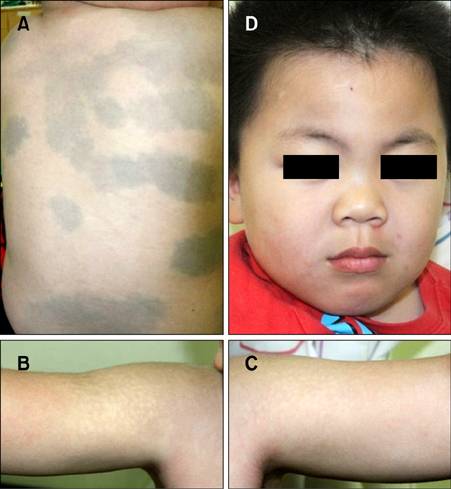Ann Dermatol.
2017 Jun;29(3):381-382. 10.5021/ad.2017.29.3.381.
Hunter Syndrome with Extensive Mongolian Spots
- Affiliations
-
- 1Department of Dermatology, School of Medicine, Pusan National University, Busan, Korea. hcko@pusan.ac.kr
- 2Bio-Medical Research Institute, Pusan National University Hospital, Busan, Korea.
- 3Department of Dermatology, Pusan National University Yangsan Hospital, Yangsan, Korea.
- 4Research Institute for Convergence of Biomedical Science and Technology, Pusan National University Yangsan Hospital, Yangsan, Korea.
- KMID: 2378550
- DOI: http://doi.org/10.5021/ad.2017.29.3.381
Abstract
- No abstract available.
MeSH Terms
Figure
Reference
-
1. Young ID, Harper PS. Mild form of Hunter's syndrome: clinical delineation based on 31 cases. Arch Dis Child. 1982; 57:828–836.
Article2. Nam KS, Lee JY, Whang KU, Kim YK. A case of Hunter's syndrome with ivory-colored papules. Ann Dermatol. 1996; 8:278–281.
Article3. Ochiai T, Ito K, Okada T, Chin M, Shichino H, Mugishima H. Significance of extensive Mongolian spots in Hunter's syndrome. Br J Dermatol. 2003; 148:1173–1178.
Article4. Schwartz IV, Ribeiro MG, Mota JG, Toralles MB, Correia P, Horovitz D, et al. A clinical study of 77 patients with mucopolysaccharidosis type II. Acta Paediatr. 2007; 96:63–70.
Article5. Parini R, Rigoldi M, Tedesco L, Boffi L, Brambilla A, Bertoletti S, et al. Enzymatic replacement therapy for Hunter disease: Up to 9 years experience with 17 patients. Mol Genet Metab Rep. 2015; 3:65–74.
Article



